

Ramé-hart Glossary. Ramé-hart Glossary of Surface Science Terms Absorption describes the behavior of a liquid the permeates a solid surface.

Adhesion (also called dispersive or adsorptive adhesion) describes the force that holds dissimilar molecules together. (See image under Wettability section.)
Science buddies. Please ensure you have JavaScript enabled in your browser.
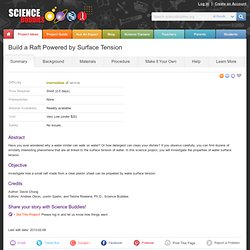
If you leave JavaScript disabled, you will only access a portion of the content we are providing. <a href="/science-fair-projects/javascript_help.php">Here's how. Hydrophobic effect. A droplet of water forms a spherical shape, minimizing contact with the hydrophobic leaf.
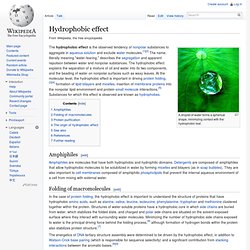
The hydrophobic effect is the observed tendency of nonpolar substances to aggregate in aqueous solution and exclude water molecules.[1][2] The name, literally meaning "water-fearing," describes the segregation and apparent repulsion between water and nonpolar substances. The hydrophobic effect explains the separation of a mixture of oil and water into its two components, and the beading of water on nonpolar surfaces such as waxy leaves. At the molecular level, the hydrophobic effect is important in driving protein folding,[3][4] formation of lipid bilayers and micelles, insertion of membrane proteins into the nonpolar lipid environment and protein-small molecule interactions.[5] Substances for which this effect is observed are known as hydrophobes.
Amphiphiles[edit] Amphiphiles are molecules that have both hydrophobic and hydrophilic domains. Folding of macromolecules[edit] Protein purification[edit] Superhydrophobe. A drop on a Lotus surface.
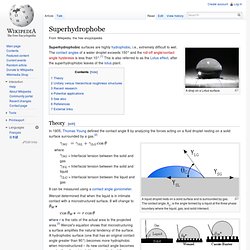
Superhydrophobic surfaces are highly hydrophobic, i.e., extremely difficult to wet. The contact angles of a water droplet exceeds 150° and the roll-off angle/contact angle hysteresis is less than 10°.[1] This is also referred to as the Lotus effect, after the superhydrophobic leaves of the lotus plant. Theory[edit] Web.ornl.gov/adm/partnerships/events/bridging_gap/presentations/Superhydrophobic_Materials.pdf. Superhydrophobicity, Learn from the Lotus Leaf. Mengnan Qu1, Jinmei He1 and Junyan Zhang2 1.
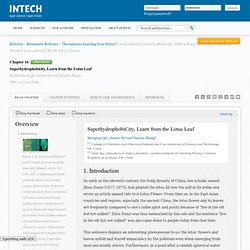
Introduction As early as the eleventh century, the Song dynasty of China, one scholar named Zhou Dunyi (1017–1073), had planted the lotus all over the poll in his home and wrote an article named Ode to A Lotus Flower. From then on, in the East Asian countries and regions, especially the ancient China, the lotus flower and its leaves are frequently compared to one’s noble spirit and purity because of “live in the silt but not sullied”. Zhou Dunyi was thus memorized by this ode and the sentence “live in the silt but not sullied” was also came down to people today from that time. This sentence displays an interesting phenomenon to us: the lotus’ flowers and leaves unfold and stayed immaculacy by the pollution even when emerging from mud and muddy waters. Contact angle. Cloth, treated to be hydrophobic, shows a high contact angle.

The contact angle is the angle, conventionally measured through the liquid, where a liquid/vapor interface meets a solid surface. It quantifies the wettability of a solid surface by a liquid via the Young equation. A given system of solid, liquid, and vapor at a given temperature and pressure has a unique equilibrium contact angle. However, in practice contact angle hysteresis is observed, ranging from the so-called advancing (maximal) contact angle to the receding (minimal) contact angle. Hydrophobicity clasification guide.
Tensiometers. Force tensiometers Measurement principle: When a solid touches the surface of a liquid, the liquid tends to be drawn up in a meniscus.

The force exerted by the meniscus is measured by a microbalance using a Du Noüy ring or a Wilhelmy plate, in either push or pull mode. The microbalance reading is used to calculate surface tension using a selection of software models. Force tensiometry is an accurate technique to measure the static surface tension and interfacial tension of liquids. These direct measurements allow the determination of dynamic contact angle, surface free energy, powder wettability, absorption, cleanliness, surface heterogeneity and density.
Click here to contact us Sigma 700/701 provide outstanding versatility with full computer control and a high level of automation. Sigma 702/702ET are open design instruments with water-jacketed holder for sample temperature control. Neverwet. Scotchgard. Pond Skater (Gerridae. The pond skater is a delicate water-based insect commonly found on still bodies of water across the Northern Hemisphere.
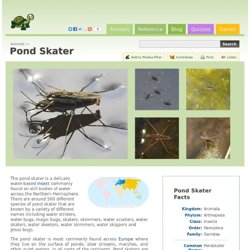
There are around 500 different species of pond skater that are known by a variety of different names including water striders, water bugs, magic bugs, skaters, skimmers, water scooters, water skaters, water skeeters, water skimmers, water skippers and Jesus bugs. The pond skater is most commonly found across Europe where they live on the surface of ponds, slow streams, marshes, and other quiet waters, in all parts of the continent. Properties of water. Water (H 2O) is the most abundant compound on Earth's surface, covering 70 percent of the planet.

In nature, water exists in liquid, solid, and gaseous states. It is in dynamic equilibrium between the liquid and gas states at standard temperature and pressure. At room temperature, it is a tasteless and odorless liquid, nearly colorless with a hint of blue. Many substances dissolve in water and it is commonly referred to as the universal solvent. Because of this, water in nature and in use is rarely pure and some properties may vary from those of the pure substance. Forms of water[edit] Electronegativity. This electrostatic potential map shows how the oxygen atom has a more negative charge (red) than the positive (blue) hydrogen atoms of a water molecule .
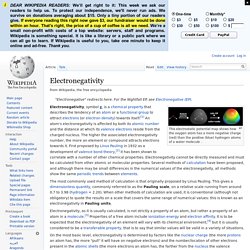
The most commonly used method of calculation is that originally proposed by Linus Pauling. This gives a dimensionless quantity, commonly referred to as the Pauling scale, on a relative scale running from around 0.7 to 3.98 (hydrogen = 2.20). When other methods of calculation are used, it is conventional (although not obligatory) to quote the results on a scale that covers the same range of numerical values: this is known as an electronegativity in Pauling units. Wetting. Water beads on a fabric that has been made non-wetting by chemical treatment. Figure 1: Droplet of water on an ideal surface. Water droplet immersed in oil and resting on a brass surface Same fluids as above, but resting on a glass surface.
Marangoni effect. History[edit] Mechanism[edit] Surface tension. Surface tension has the dimension of force per unit length, or of energy per unit area. The two are equivalent—but when referring to energy per unit of area, people use the term surface energy—which is a more general term in the sense that it applies also to solids and not just liquids. Scientific Victorian. Surface energy. Surface tension. In materials science, surface tension is used for either surface stress or surface free energy. Causes[change | edit source] Web.mit.edu/1.63/www/Lec-notes/Surfacetension/Lecture3.pdf. Surface Tension. Capillary surface.